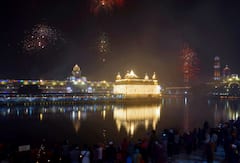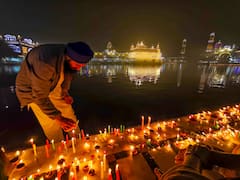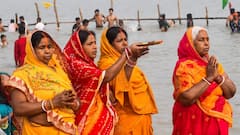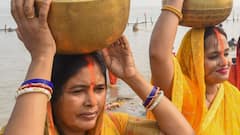Durga Puja 2024: Auspicious Colours To Wear On Each Day Of The Festival
Durga Puja celebrates the triumph of Goddess Durga over evil. Each day has a significance, and wearing specific colours enhances the festivities and spirituality during this vibrant festival.

Durga Puja 2024:
India celebrates Durga Puja, a colourful celebration that's dedicated to Goddess Durga and her conquest of the buffalo demon, Mahishasur. This magnificent celebration, which lasts for nine days, unites community, culture, and devotion.
Each day of the event has its own importance, signified by distinct colours that devotees wear to attract blessings and positivity. Each shade of these lucky hues represents a different quality of the goddess, and it is said that they will draw heavenly grace and heighten the joyful mood. Every hue, from the vigor of red to the purity of white, has a special significance that fits well with the festivities of the day. Embracing these colors as Durga Puja 2024 draws near enhances the occasion and strengthens the bond with the almighty, making it a memorable and spirituallu uplifting occasion.
Also Read: When Is Mahalaya 2024? Know On Which Vehicle Maa Durga Is Arriving This Year, And Durga Puja Dates
Day 1 - Yellow
Devotees honour Goddess Shailputri, daughter of the mountains and embodiment of Goddess Parvati, on the first day of Durga Puja. She is the first incarnation of Goddess Durga, representing strength and purity. It's customary to wear yellow on this auspicious day. Yellow denotes knowledge and wisdom, and its bright, joyful tone emphasises the excitement and positivity of the festival. It also sets a positive tone for the days ahead by representing hope and the possibility of fresh starts.
Day 2 - White
Wearing green, devotees honour Goddess Brahmacharini, the single form of Goddess Parvati, on the second day of Durga Puja. Legend has it that she wears white to represent the extreme penance she underwent to gain Lord Shiva as her husband. White is the colour of serenity, intellect, wisdom, purity and spiritual enlightenment. On this day, devotees appreciate these attributes by paying reverence to the deity.
Day 3 - Red
Devotees honour Devi Chandraghanta, the married form of Goddess Parvati, on the third day of Durga Puja. This aspect of the goddess, recognised for her great power and strength, represents courage, grace, and bravery. Goddess Chandraghanta is shown wearing the colour red, which stands for her ferocious force. Devotees also wear red in her honour, signifying sacrifice, passion, strength, and vitality as they beg her blessings.
Day 4 - Orange
Devotees wear orange on the fourth day of Navratri as a tribute to Goddess Kushmanda, the universe's creator. The goddess's contribution to bringing light and life into the universe is reflected in this vivid colour. Orange is associated with contentment and hope, representing the happy. It also represents confidence and courage, attributes that followers of Goddess Kushmanda ask for in their prayers.
Day 5 - Grey
On the fifth day of Durga Puja, Goddess Skandamata is worshipped. She represents motherhood, compassion, and an abundantly loving heart. Devotees wear grey on this day, a colour that represents transformation and the fortitude required for personal development. Grey is the colour of calm and composure, which are essential for overcoming obstacles and encouraging emotional equilibrium and a sense of groundedness. Devotees revere the goddess by dressing in gray and ask her for direction on how to confront life's challenges with grace and resiliency.
Day 6 - Green
Goddess Katyayani is worshipped on the sixth day of Durga Puja, and her followers wear green on this day. Green represents the goddess's courage, defense, and dedication to her follower's welfare. It is said that on this day, wearing green will bring the goddess's tranquil favours. Additionally, it represents new beginnings and inspires hope and trust for the future. Devotees connect with the strength and rejuvenation that Goddess Katyayani embodies by donning this colour.
Day 7 - Royal Blue
Wearing royal blue on the seventh day of Durga Puja, devotees pay homage to Goddess Kalratri, who is revered for her strong yet protective demeanour. The colour represents the goddess's great strength and deep wisdom. The colour royal blue is associated with calm and authority, which aids in the inner power and tranquility of those who wear it.
Day 8 - Purple
Wearing purple on the eighth day of Navratri is a symbol of devotion to Goddess Mahagauri, who is honoured on this day. Purple is associated with grandeur, luxury, and nobility, representing the goddess's celestial grace. Additionally, it is thought to raise spiritual awareness, cultivate calm, and facilitate a connection between devotees and the serene, pure energies of Goddess Mahagauri.
Day 9 - Peacock Green
Wearing peacock green on the ninth day of Navratri, devotees pay respect to Goddess Siddhidatri, the ninth incarnation of Goddess Durga. This vivid hue represents the goddess's capacity to provide all siddhis, or spiritual abilities. Peacock green symbolises the realisation of dreams and objectives by reflecting the beauty, splendor, and majesty of nature. It also represents abundance and diversity, representing the bounty of life and the gifts bestowed upon her devotees by Goddess Siddhidatri.
Trending News
Top Headlines








































